Analyzing Market Structures: A Microeconomics Assignment
VerifiedAdded on 2021/04/21
|7
|1033
|63
Homework Assignment
AI Summary
This economics assignment delves into the analysis of various market structures, including monopolistic competition, monopoly, oligopoly, and perfect competition. The assignment begins by comparing and contrasting monopolistic competition with both pure monopoly and perfect competition, highlighting their similarities and differences. It then defines and explains the concept of normal profit, emphasizing its role in covering both explicit and implicit costs. The document further explores the conditions that lead to above-normal profit in different market structures, such as monopoly and oligopoly, and contrasts these with the conditions in perfectly competitive and monopolistically competitive markets. Finally, the assignment applies these concepts by classifying real-world examples like McDonald's, ExxonMobil, Dell, and Starbucks into their respective market structures, providing a practical understanding of the theoretical concepts discussed.
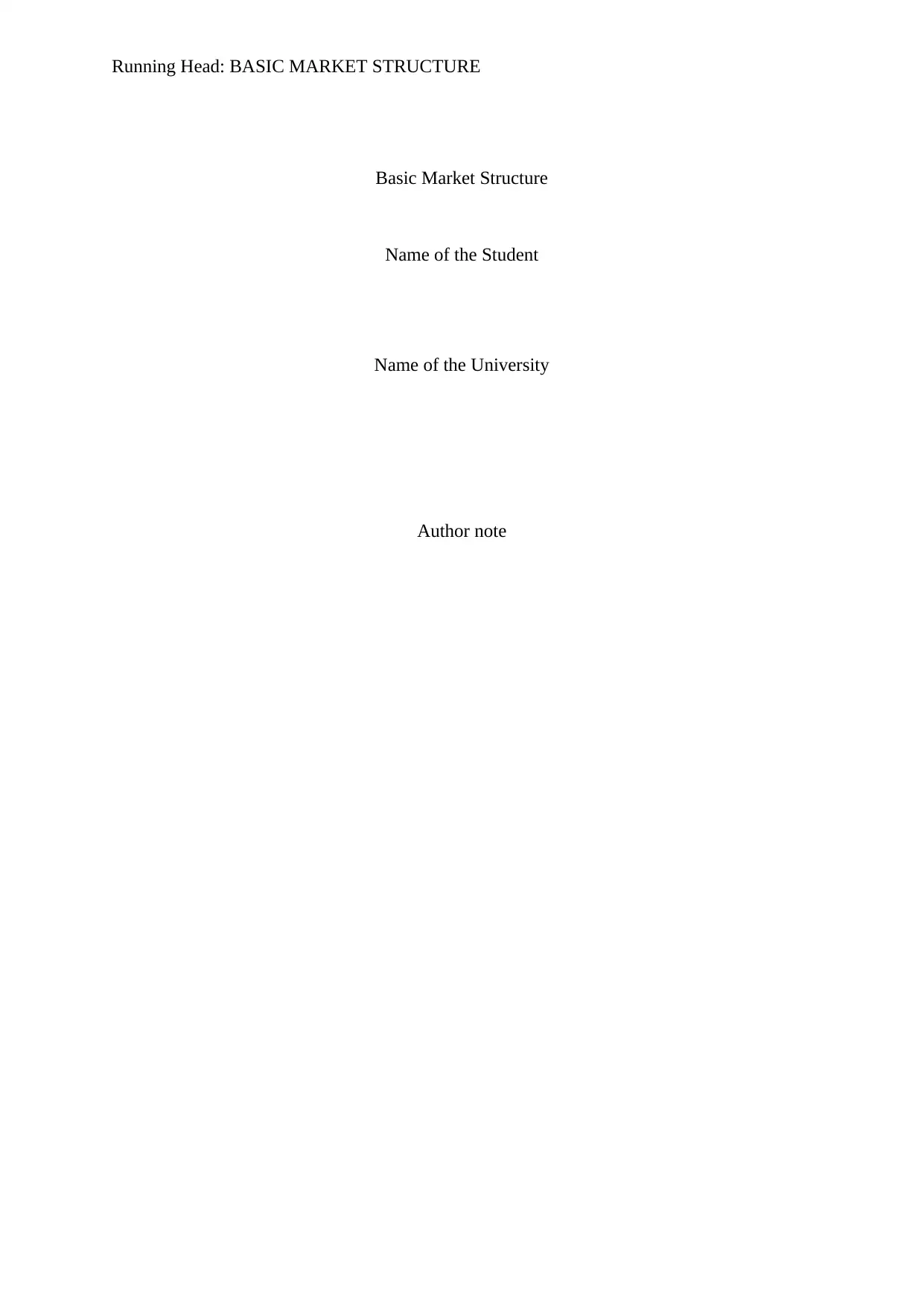
Running Head: BASIC MARKET STRUCTURE
Basic Market Structure
Name of the Student
Name of the University
Author note
Basic Market Structure
Name of the Student
Name of the University
Author note
Paraphrase This Document
Need a fresh take? Get an instant paraphrase of this document with our AI Paraphraser
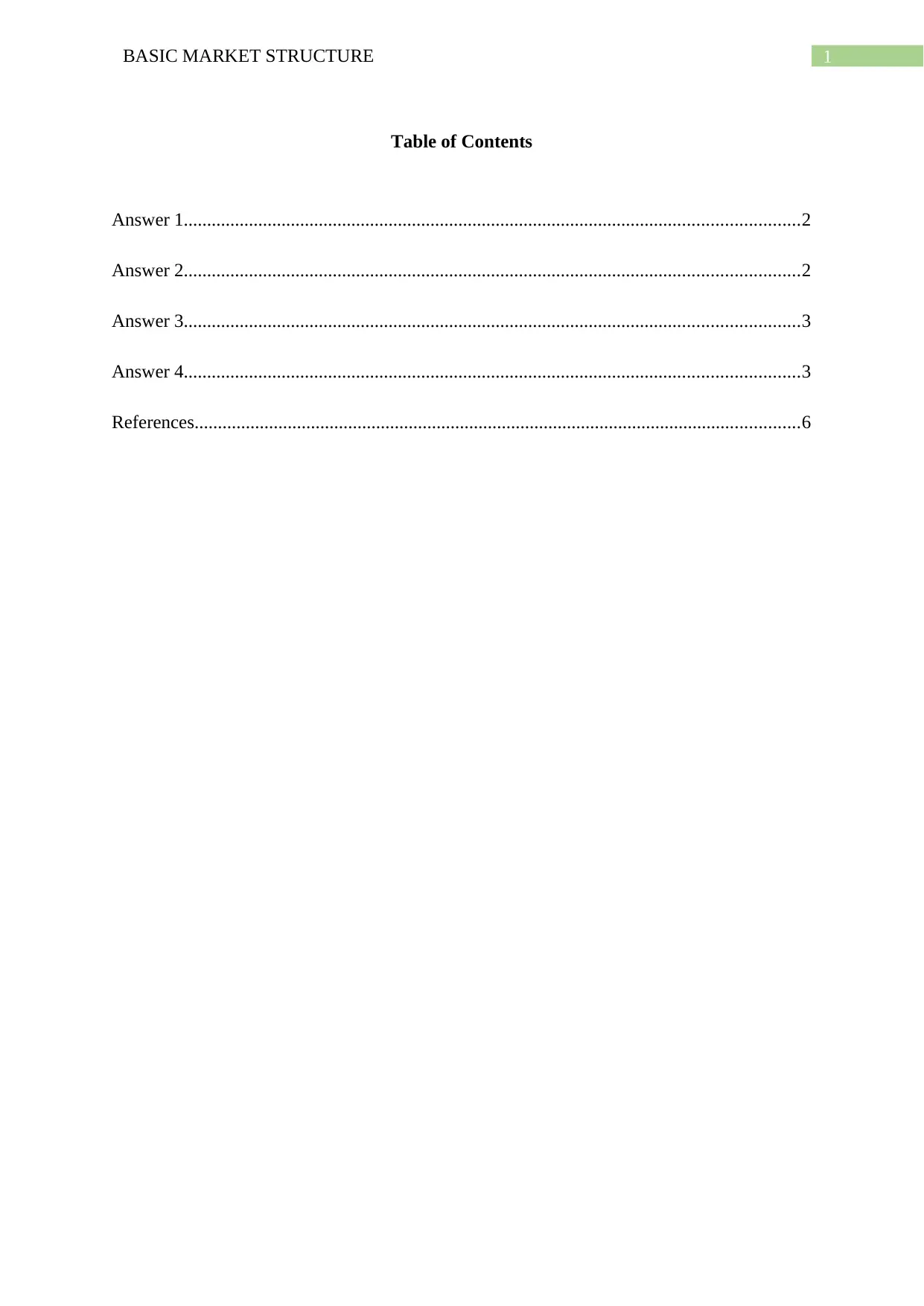
1BASIC MARKET STRUCTURE
Table of Contents
Answer 1....................................................................................................................................2
Answer 2....................................................................................................................................2
Answer 3....................................................................................................................................3
Answer 4....................................................................................................................................3
References..................................................................................................................................6
Table of Contents
Answer 1....................................................................................................................................2
Answer 2....................................................................................................................................2
Answer 3....................................................................................................................................3
Answer 4....................................................................................................................................3
References..................................................................................................................................6
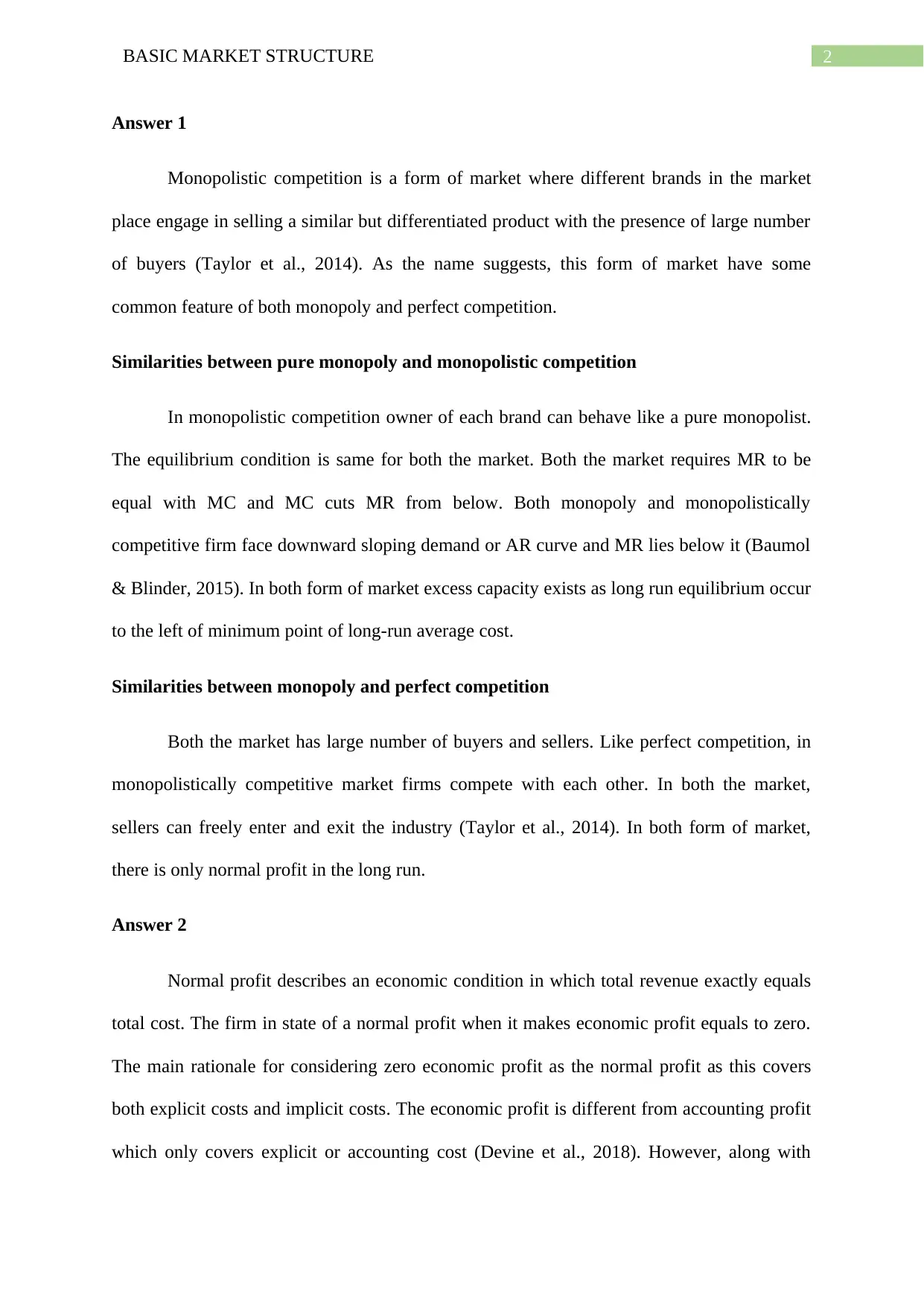
2BASIC MARKET STRUCTURE
Answer 1
Monopolistic competition is a form of market where different brands in the market
place engage in selling a similar but differentiated product with the presence of large number
of buyers (Taylor et al., 2014). As the name suggests, this form of market have some
common feature of both monopoly and perfect competition.
Similarities between pure monopoly and monopolistic competition
In monopolistic competition owner of each brand can behave like a pure monopolist.
The equilibrium condition is same for both the market. Both the market requires MR to be
equal with MC and MC cuts MR from below. Both monopoly and monopolistically
competitive firm face downward sloping demand or AR curve and MR lies below it (Baumol
& Blinder, 2015). In both form of market excess capacity exists as long run equilibrium occur
to the left of minimum point of long-run average cost.
Similarities between monopoly and perfect competition
Both the market has large number of buyers and sellers. Like perfect competition, in
monopolistically competitive market firms compete with each other. In both the market,
sellers can freely enter and exit the industry (Taylor et al., 2014). In both form of market,
there is only normal profit in the long run.
Answer 2
Normal profit describes an economic condition in which total revenue exactly equals
total cost. The firm in state of a normal profit when it makes economic profit equals to zero.
The main rationale for considering zero economic profit as the normal profit as this covers
both explicit costs and implicit costs. The economic profit is different from accounting profit
which only covers explicit or accounting cost (Devine et al., 2018). However, along with
Answer 1
Monopolistic competition is a form of market where different brands in the market
place engage in selling a similar but differentiated product with the presence of large number
of buyers (Taylor et al., 2014). As the name suggests, this form of market have some
common feature of both monopoly and perfect competition.
Similarities between pure monopoly and monopolistic competition
In monopolistic competition owner of each brand can behave like a pure monopolist.
The equilibrium condition is same for both the market. Both the market requires MR to be
equal with MC and MC cuts MR from below. Both monopoly and monopolistically
competitive firm face downward sloping demand or AR curve and MR lies below it (Baumol
& Blinder, 2015). In both form of market excess capacity exists as long run equilibrium occur
to the left of minimum point of long-run average cost.
Similarities between monopoly and perfect competition
Both the market has large number of buyers and sellers. Like perfect competition, in
monopolistically competitive market firms compete with each other. In both the market,
sellers can freely enter and exit the industry (Taylor et al., 2014). In both form of market,
there is only normal profit in the long run.
Answer 2
Normal profit describes an economic condition in which total revenue exactly equals
total cost. The firm in state of a normal profit when it makes economic profit equals to zero.
The main rationale for considering zero economic profit as the normal profit as this covers
both explicit costs and implicit costs. The economic profit is different from accounting profit
which only covers explicit or accounting cost (Devine et al., 2018). However, along with
⊘ This is a preview!⊘
Do you want full access?
Subscribe today to unlock all pages.

Trusted by 1+ million students worldwide
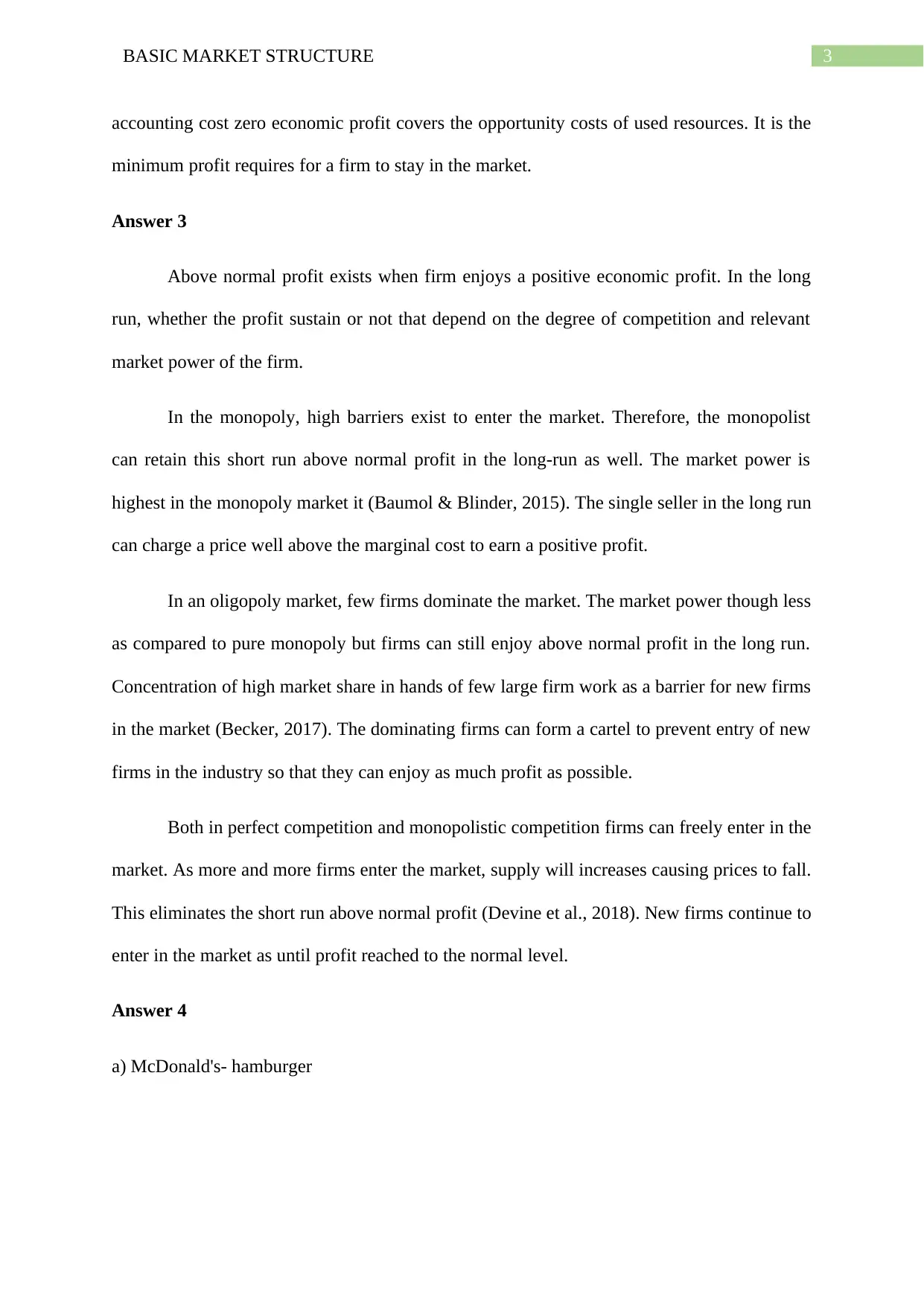
3BASIC MARKET STRUCTURE
accounting cost zero economic profit covers the opportunity costs of used resources. It is the
minimum profit requires for a firm to stay in the market.
Answer 3
Above normal profit exists when firm enjoys a positive economic profit. In the long
run, whether the profit sustain or not that depend on the degree of competition and relevant
market power of the firm.
In the monopoly, high barriers exist to enter the market. Therefore, the monopolist
can retain this short run above normal profit in the long-run as well. The market power is
highest in the monopoly market it (Baumol & Blinder, 2015). The single seller in the long run
can charge a price well above the marginal cost to earn a positive profit.
In an oligopoly market, few firms dominate the market. The market power though less
as compared to pure monopoly but firms can still enjoy above normal profit in the long run.
Concentration of high market share in hands of few large firm work as a barrier for new firms
in the market (Becker, 2017). The dominating firms can form a cartel to prevent entry of new
firms in the industry so that they can enjoy as much profit as possible.
Both in perfect competition and monopolistic competition firms can freely enter in the
market. As more and more firms enter the market, supply will increases causing prices to fall.
This eliminates the short run above normal profit (Devine et al., 2018). New firms continue to
enter in the market as until profit reached to the normal level.
Answer 4
a) McDonald's- hamburger
accounting cost zero economic profit covers the opportunity costs of used resources. It is the
minimum profit requires for a firm to stay in the market.
Answer 3
Above normal profit exists when firm enjoys a positive economic profit. In the long
run, whether the profit sustain or not that depend on the degree of competition and relevant
market power of the firm.
In the monopoly, high barriers exist to enter the market. Therefore, the monopolist
can retain this short run above normal profit in the long-run as well. The market power is
highest in the monopoly market it (Baumol & Blinder, 2015). The single seller in the long run
can charge a price well above the marginal cost to earn a positive profit.
In an oligopoly market, few firms dominate the market. The market power though less
as compared to pure monopoly but firms can still enjoy above normal profit in the long run.
Concentration of high market share in hands of few large firm work as a barrier for new firms
in the market (Becker, 2017). The dominating firms can form a cartel to prevent entry of new
firms in the industry so that they can enjoy as much profit as possible.
Both in perfect competition and monopolistic competition firms can freely enter in the
market. As more and more firms enter the market, supply will increases causing prices to fall.
This eliminates the short run above normal profit (Devine et al., 2018). New firms continue to
enter in the market as until profit reached to the normal level.
Answer 4
a) McDonald's- hamburger
Paraphrase This Document
Need a fresh take? Get an instant paraphrase of this document with our AI Paraphraser
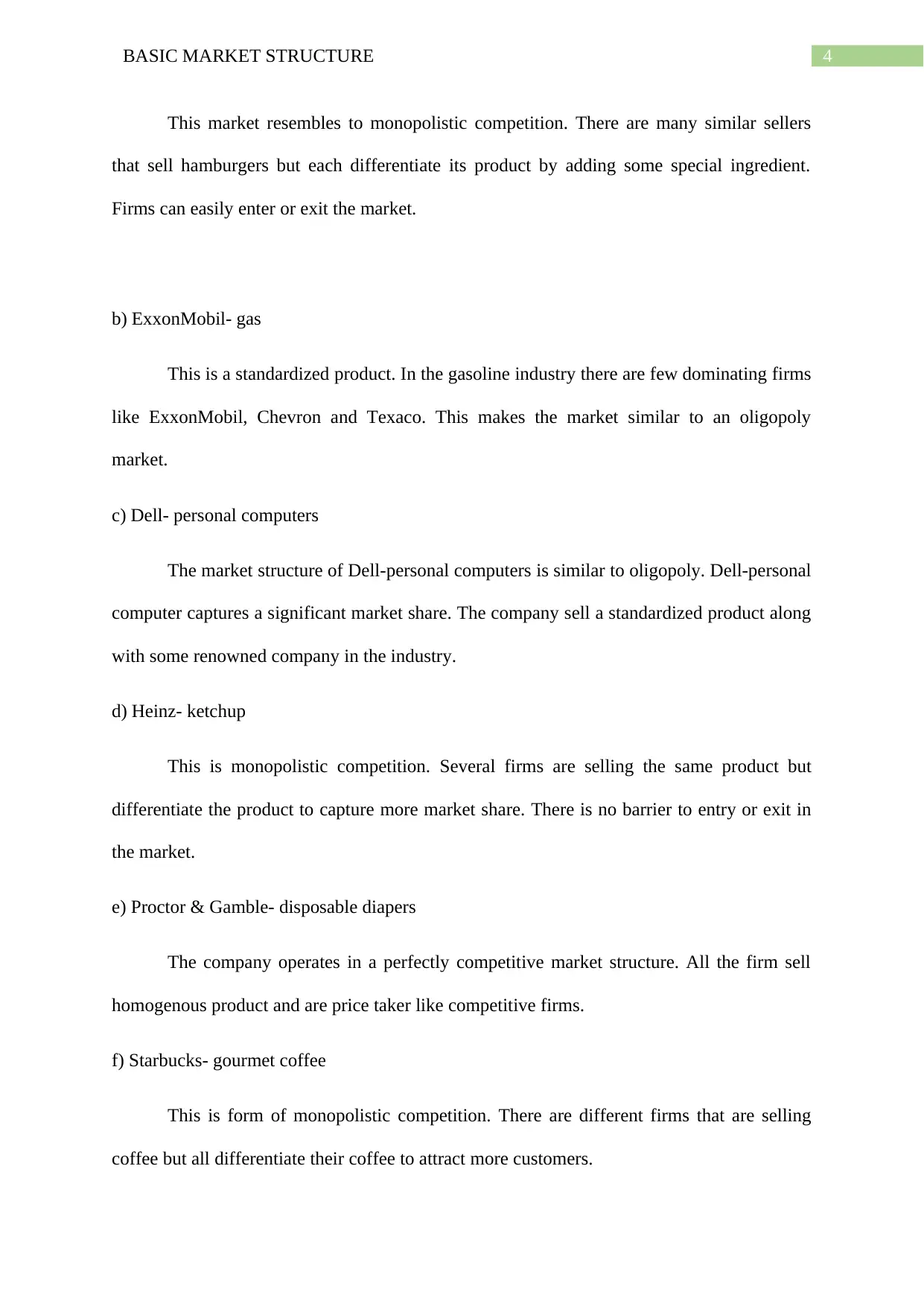
4BASIC MARKET STRUCTURE
This market resembles to monopolistic competition. There are many similar sellers
that sell hamburgers but each differentiate its product by adding some special ingredient.
Firms can easily enter or exit the market.
b) ExxonMobil- gas
This is a standardized product. In the gasoline industry there are few dominating firms
like ExxonMobil, Chevron and Texaco. This makes the market similar to an oligopoly
market.
c) Dell- personal computers
The market structure of Dell-personal computers is similar to oligopoly. Dell-personal
computer captures a significant market share. The company sell a standardized product along
with some renowned company in the industry.
d) Heinz- ketchup
This is monopolistic competition. Several firms are selling the same product but
differentiate the product to capture more market share. There is no barrier to entry or exit in
the market.
e) Proctor & Gamble- disposable diapers
The company operates in a perfectly competitive market structure. All the firm sell
homogenous product and are price taker like competitive firms.
f) Starbucks- gourmet coffee
This is form of monopolistic competition. There are different firms that are selling
coffee but all differentiate their coffee to attract more customers.
This market resembles to monopolistic competition. There are many similar sellers
that sell hamburgers but each differentiate its product by adding some special ingredient.
Firms can easily enter or exit the market.
b) ExxonMobil- gas
This is a standardized product. In the gasoline industry there are few dominating firms
like ExxonMobil, Chevron and Texaco. This makes the market similar to an oligopoly
market.
c) Dell- personal computers
The market structure of Dell-personal computers is similar to oligopoly. Dell-personal
computer captures a significant market share. The company sell a standardized product along
with some renowned company in the industry.
d) Heinz- ketchup
This is monopolistic competition. Several firms are selling the same product but
differentiate the product to capture more market share. There is no barrier to entry or exit in
the market.
e) Proctor & Gamble- disposable diapers
The company operates in a perfectly competitive market structure. All the firm sell
homogenous product and are price taker like competitive firms.
f) Starbucks- gourmet coffee
This is form of monopolistic competition. There are different firms that are selling
coffee but all differentiate their coffee to attract more customers.
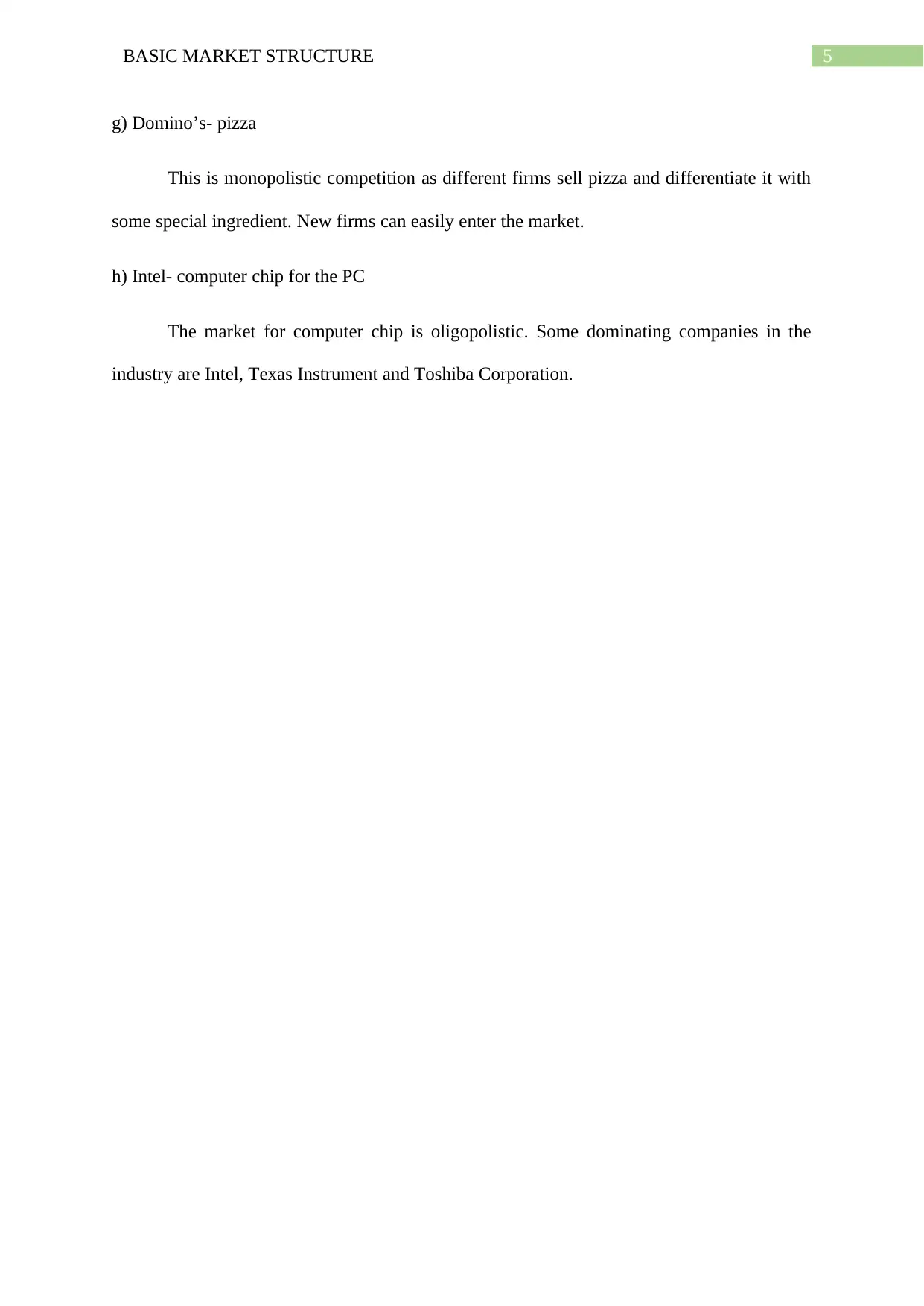
5BASIC MARKET STRUCTURE
g) Domino’s- pizza
This is monopolistic competition as different firms sell pizza and differentiate it with
some special ingredient. New firms can easily enter the market.
h) Intel- computer chip for the PC
The market for computer chip is oligopolistic. Some dominating companies in the
industry are Intel, Texas Instrument and Toshiba Corporation.
g) Domino’s- pizza
This is monopolistic competition as different firms sell pizza and differentiate it with
some special ingredient. New firms can easily enter the market.
h) Intel- computer chip for the PC
The market for computer chip is oligopolistic. Some dominating companies in the
industry are Intel, Texas Instrument and Toshiba Corporation.
⊘ This is a preview!⊘
Do you want full access?
Subscribe today to unlock all pages.

Trusted by 1+ million students worldwide
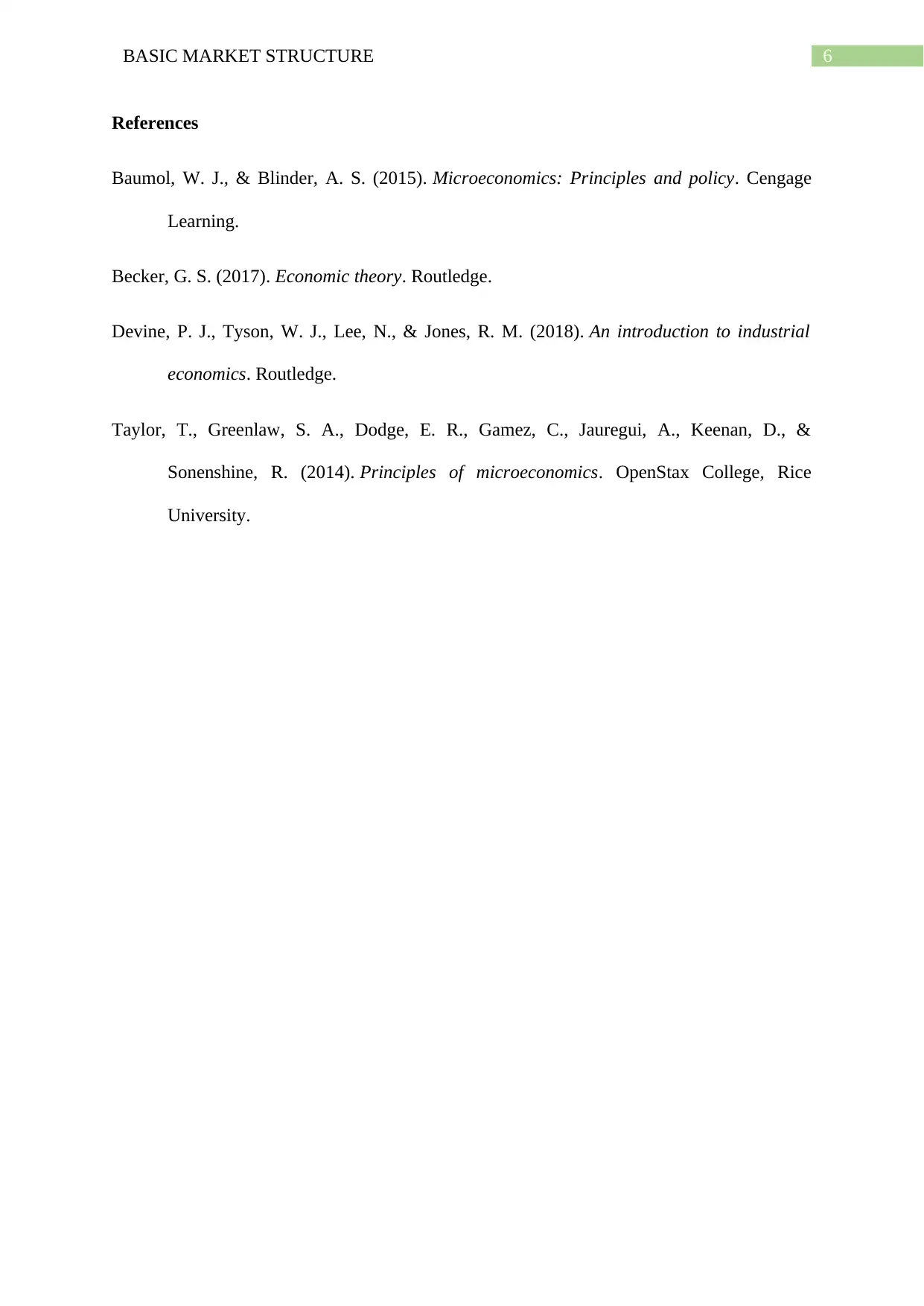
6BASIC MARKET STRUCTURE
References
Baumol, W. J., & Blinder, A. S. (2015). Microeconomics: Principles and policy. Cengage
Learning.
Becker, G. S. (2017). Economic theory. Routledge.
Devine, P. J., Tyson, W. J., Lee, N., & Jones, R. M. (2018). An introduction to industrial
economics. Routledge.
Taylor, T., Greenlaw, S. A., Dodge, E. R., Gamez, C., Jauregui, A., Keenan, D., &
Sonenshine, R. (2014). Principles of microeconomics. OpenStax College, Rice
University.
References
Baumol, W. J., & Blinder, A. S. (2015). Microeconomics: Principles and policy. Cengage
Learning.
Becker, G. S. (2017). Economic theory. Routledge.
Devine, P. J., Tyson, W. J., Lee, N., & Jones, R. M. (2018). An introduction to industrial
economics. Routledge.
Taylor, T., Greenlaw, S. A., Dodge, E. R., Gamez, C., Jauregui, A., Keenan, D., &
Sonenshine, R. (2014). Principles of microeconomics. OpenStax College, Rice
University.
1 out of 7
Related Documents
Your All-in-One AI-Powered Toolkit for Academic Success.
+13062052269
info@desklib.com
Available 24*7 on WhatsApp / Email
![[object Object]](/_next/static/media/star-bottom.7253800d.svg)
Unlock your academic potential
Copyright © 2020–2025 A2Z Services. All Rights Reserved. Developed and managed by ZUCOL.





